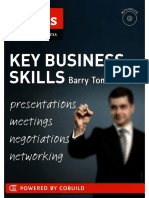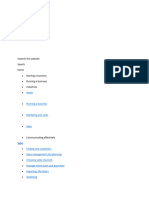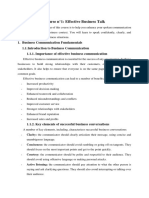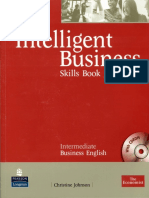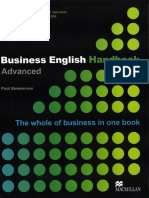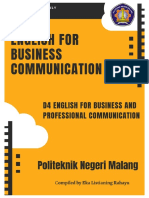0 ratings0% found this document useful (0 votes)
14 views142 pagesCollins Key Business Skills
The document outlines a business communication skills course, 'Key Business Skills,' which focuses on networking, presentations, meetings, and negotiations. It includes 12 units with structured lessons that cover essential skills such as introductions, active listening, and effective presentation techniques. The course is designed for business learners at B1-C1 level and provides resources for self-study or classroom use, including a book and accompanying audio CD.
Uploaded by
sabrinaqoreCopyright
© © All Rights Reserved
We take content rights seriously. If you suspect this is your content, claim it here.
Available Formats
Download as PDF or read online on Scribd
0 ratings0% found this document useful (0 votes)
14 views142 pagesCollins Key Business Skills
The document outlines a business communication skills course, 'Key Business Skills,' which focuses on networking, presentations, meetings, and negotiations. It includes 12 units with structured lessons that cover essential skills such as introductions, active listening, and effective presentation techniques. The course is designed for business learners at B1-C1 level and provides resources for self-study or classroom use, including a book and accompanying audio CD.
Uploaded by
sabrinaqoreCopyright
© © All Rights Reserved
We take content rights seriously. If you suspect this is your content, claim it here.
Available Formats
Download as PDF or read online on Scribd
You are on page 1/ 142
Semel m ec esy
KEY BUSINESS
SKILLS Barry Tomalin
RCL. >
meetings hy
negotiations f
networking
Contents
Introduction
Networking
Unit 1 Introductions
A How to introduce yourself
B How to describe your current project
Unit 2 Listening
A Active listening ~ the key to networking
B Using FACE.
Unit 3 Small talk
A How to start a conversation
B How to avoid causing offence
Presentations
Unit 4 Presentation organization
‘A How to structure your presentation
B How to deal with questions and interruptions
Unit 5 Preparation and delivery
A How to prepare
B Joint presentations
Unit 6 Presentation style
‘A Presentation delivery techniques
B Voice and visuals
Meetings
Unit 7 Running a successful me
A Setting the agenda
B Taking the minutes and keeping control
Unit 8 Participating in meetings
A Making your point in meetings
B Giving your opinion
Unit 9 Conference calls
A Taking part in telephone conference calls
B Taking part in video-conference calls
Negotiations
Unit 10 International negotiations
A Presenting your organization at the beginning of a negotiation
B The five stages of a negotiation
Unit 11 Negotiation styles
A Preparing and exploring
B Proposing and bargaining
Unit 12 Closing the negotiation
‘A Reaching agreement
B Dealing with last-minute problems
ing
Business file - additional reference material
Answer key
Audio scripts
16
24
32
40
48
56
64
72
80
88
96
104
113
122
Introduction
Collins English for Business: Key Business Skills will help you communicate successfully either
internationally company-to-company or within a multinational company.
You can use Key Business Skills:
© asa self-study course
* as a resource for business communication or business English courses
Key Business Skills focuses on four key communication skills areas:
© Networking * Presentations * Meetings * Negotiations
Key Business Skills comprises a book and CD. The book has 12 units. At the back of the book
there i
© the Business file ~ additional reference material
© the Answer key
* the Audio scripts for the audio recordings
Unit structure
Each of the 12 units of Key Business Skills is divided into two parts.
Part A contains these sections:
* Aims - This sets out the objectives for both Parts A and B of the unit.
* Quiz ~ This raises self-awareness about the topic and introduces the communication skills
focus for both Parts A and B of the unit.
* Briefing ~ This presents the communication skills for Part A.
* Listening - This gives you the opportunity to listen to a conversation, presentation, meeting
oF negotiation that shows you how to use the communication skills you have read about in
the Briefing,
* Business practice - This presents the key language and provides speaking and vocabulary
practice based on the communication skills,
* Business culture — This provides information on how the communication skills you have
learned may differ in different international situations.
Part B contains these sections:
* Briefing ~ This presents the communication skills focus for Part 8.
* Listening ~ This gives you the opportunity to listen to a conversation, presentation, meeting
‘or negotiation that shows you how to use the communication skills you have read about in
the Briefing
* Business practice — This presents the key language and provides speaking and vocabulary
practice based on the communication skills.
* Business writing ~ This provides presentation and practice of wi
the unit topic.
ing tasks associated with
6 | Key Business Skills
Introduction
© Key take-aways ~ This is a reflective section to help you record what you have learned and
how you will use it in future,
© Business file ~ This section at the back of the book provides you with additional reference
material for the Business culture and Business writing parts in some of the units.
Using the CD
§ ¥ this icon indicates that there is an audio track that you should listen to. The CD contains the
MP3 files for the Listening and Business practice sections. Please note that the Key Business Skills
CD is designed for use with a computer. If you want to play the audio on a CD player, you should
download the tracks to your computer and then burn all the tracks onto an audio CD.
“Business Plus’ approach
This book uses the ‘Business Plus’ approach that teaches you international business skills AND
provides you with the language you need. An important part of this approach is the teaching
and practice of the set phrases which international managers use all the time in international
communication. The Business practice sections in the book contain these phrases together with
audio support so that you can listen and repeat and become fluent at using these phrases.
Powered by COBUILD
Words or phrases in Key Business Skills that were felt too advanced for intermediate (81)
learners have been glossed using the definitions from the Collins COBUILD Advanced Dictionary.
Using Key Business Skills
You can either work through the units from Unit 1 to Unit 12 or you can choose the units and
topics that are most useful to you, The Contents page will help in your selection of units for study.
Study tips
© Each unit takes about two hours - one hour per part. Take regular breaks and do not try to
study for too long. Thirty minutes is a sensible study period.
© Regular study is better than occasional intensive study.
Read the unit through first to get an overview without doing any exercises. This will help
you see what you want to focus on
* Put the audio tracks on your mobile phone or MP3 player so you can listen to the
conversations as many times as you need to and do the activities on your way to work or
when you are out and about.
* Try to find someone with whom you can practise your English, either face-to-face, over the
phone or online using a webcam
© Make sure you complete the Key take-aways section and refer to it regularly. it will remind
you of what you have found useful, and how and when you intend to apply it.
Language level
Key Business Skills has been written for business learners at B1-C1 level of the Common European
Framework of Reference for Languages (CEFR) (Intermediate to Advanced)
Other titles
Also available in the Collins English for Business series: Listening, Speaking, Reading and Writing.
Introduction |
7
You never get a second chance to make a first impression.
4 Introductions
Sarco Meee
NVI Ta Oe SRN Tan)
NVM ecto UICC Ta
DSO Na Re eens Sig
What information do you like or need to give when you introduce
yourself? Tick the boxes.
name
address
nationality
qualifications
1
2
3
4
\| 5 jobtitle
6 company |
7 responsibilities
8 company location
9 purpose of visit
10. family information
8 Key Business Skills
TA How to introduce yourselt
The elevator pitch
Imagine you are in the elevator of an office you are visiting. You recognize that an important
client who does not know you is standing there. You have a maximum of 30 seconds to introduce
yourself and make an impression. Think about what you will say. Then read the Briefing.
eS
Briefing _ ee
Making a good first impression is an important skill but most people don’t do it very well. They
get confused. They say the wrong thing. They forget the most important information,
So what do you need to say? Remember these six things.
1 Name Say your name CLEARLY. Pause between your given (first) name and your
family name.
2 Nationality Say where you come from. This may help people identify your accent and
make you easier to understand.
3 Job Say your job. Give your job title or say what your job is.
4 Company Give the company name. Say which company you work for.
5. Location Give the location of the company.
6 Pitch Make a pitch. Give a reason for talking to the person. Say why you are
here. Describe in one sentence your responsibilit
do to make the other person interested in you.
ies. A pitch is what you
Be careful about:
* shaking hands ~ maybe wait until they offer you their hand.
* making jokes ~ people can take them seriously, misunderstand or be insulted.
* asking people to do something - they may not be able to help or they may not want to.
Don't alienate people, encourage them.
fas = —
(Listening
Listen to seven people introducing themselves at an international conference. They did
not include all the information about themselves. Put a tick if they gave the information
Which speaker gave all the necessary information?
LEU Auris ry rt Aa oxelstol
Speaker 1 |
| Speaker 2
| speaker3 | | |
| Speaker 4 |
| Speaker 5
Speaker 6
Speaker 7
Networking | 9
Listen again to the seven people and say if these statements are true or false.
1 Speaker 1 is a human resources manager. True False
2. Speaker 2 works for a petrol station company. True False
3. Speaker 3 is based in London True False
4 Speaker 4 works in Edinburgh, TrueO False
5. Speaker 5's company has its headquarters in Stuttgart. True (J. False (1
6 Speaker 6 works in Europe. True False
7 Speaker 7 works in Kerala, India. TueO False
r
| Business practice
GQ EI Uisten and repeat these sentences.
A
Say hello
Say where you are
from
Say what your job is
Say where you work
Give the company's
location
Say why you are here
and what you are
Hi, I'm (your name).
Hello, my name's (your name).
Good morning / Good afternoon / Good evening, my name's ...
Can / May | introduce myself? My name's...
I'm from Rio de Janeiro in Brazil.
'm Brazilian.
I come from Rio.
I'm a project manager and IT specialist.
I work as an accountant for a big US corporation.
| work for / with Petrobras, the oil and gas company.
The company is based in Rio de Janeiro.
We're locates
a suburb of Stuttgart.
I'm responsible for overseas suppliers and I'm here to make an
agreement with a new contractor.
doing
BL Test yourself. Cover the sentences above and then complete these sentences.
1 I'm responsible z sales in Eastern Europe.
2 I give you my card?
3 The companys... in Switzerland
10 | Key Business Skils
1A How to introduce yourself
4 I'm the USA.
SPM ssessseseneeenes tO Network,
6 I'm for IT systems.
7 The companyis...... in the city centre
8 Hi, may! myself?
Listen to this introduction and repeat it. Try to copy the intonation.
Hello. May | introduce myself? I'm Alex Johnson. I'm from Leeds in the UK. I'ma
systems analyst in IBM, based in Leeds, and I'm currently working with a team |
here to evaluate our new telecoms application.
Now record your own introduction. Don't forget to make your pitch. Listen to it and
compare. Did you sound clear, interesting and friendly? If you can, ask a colleague or
friend to listen to it to give you their opinion.
| Business culture
People in different parts of the world have different customs when exchanging business cards.
Study this table. What is the etiquette where you live and work?
Give the business card at any time. Offer the card first when you meet.
Don't do a special presentation. | Offer it with both hands, card facing outwards.
Give it with one hand or leave it on the table. | Read it carefully and comment.
Put it in a pocket or notebook. Put it in a card holder.
Write extra information on it if you need to. Never write on it.
What's the difference? In Europe, and also in the Americas, the business card is simply a means
of follow-up contact. In Asia it is a ritual and a record of your business network. If you treat the
business card seriously, it means you are serious about the people you are meeting.
Neoworking | 14
@ your current project
ae How to desci
(Briefing _ _
It is important to be able to describe your current project - what you are working on right now.
Use this formula to describe your job and your current project simply and clearly.
Ll Project title First, say what the name of your project is.
7M Project Next, say what its aims are.
[8 Project process Then say how you are organizing you project.
[e}l Project outcome Finally, say what the outcome or result will be.
if you do this well, your partner or client will be able to ask questions to get more information
or to clarify anything that is necessary.
ie
(Listening
Here are four PAPO descriptions. Listen and write down the key information, Pause the
audio and listen again when you need to.
Current project 1 Current project 2
to i
ry ry
ti i
° °
Current project 3 Current project 4
i P
A A
P P
Ce) ()
12 | Key Business Skills
Qa
(Bus ness practice
1B How to describe your current project
Listen again to the four PAPO descriptions.
1 In Current project 1 what word or phrase tells you that the schedule for the report will
be difficult to achieve?
2. In Current project 2 what word or phrase tells you there is an obligation to submit the
bid by the end of the year?
3 In Current project 3 what word or phrase means now?
4. In Current project 4 what word or phrase means the same as aim?
Qu
LP |
Listen and repeat these sentences.
How to describe your project title
The focus of my current project is
The project I'm working on right now is ...
The project I'm currently responsible for is...
How to describe your project aim
The aims and objectives of the project are ...
It’s a project which is designed to
The project aims to ...
How to describe your project process
The project is organized in three stages: plan, build and run.
There are three phases in the project: project research, materials design
and project dissemination.
The project is divided into three main areas: sourcing contractors,
agreeing contracts and managing the supply chain
How to describe your project outcome
You can describe the project outcomes in terms of QUALITY or of TIME.
QUALITY OUTCOMES
The project outcomes will be increased customer support, reduced
customer complaints and higher overall customer satisfaction
The outcome of the project will be improved performance and deeper
staff engagement with the product and with the company.
TIME OUTCOMES
Stage one will be completed by December.
The project is due for completion by this time next year.
‘To disseminate
information or
knowledge means
to distribute it so
that it reaches
many people or
‘organizations.
Networking | 13
Test yourself. Complete the sentences with words from the box.
based ‘outcome: responsible purpose
agreement contractor supplier overseas
1 hope the... of this negotiation will be successful.
2 Fall goes well we expect to make aN verve by Next month.
3 Im for the supply chain.
A Tell me the ...esssesecnue OF YOUF visit
5B Mm a... to some of the largest companies in Britain.
6 My company is ..-.sese-senessiM Dusseldorf in Germany but | work in Delhi.
7 ‘I'mhere to find a. to build the new power station.
8 My job is to manage ‘operations.
EI __ Test yourself. Complete the sentences with prepositions from the box.
{on in for |
11 My company is based ......:sse-s- Thailand.
2. I'm responsible four hundred employees.
Bo DWotk .eseeocneeneea large multinational.
4 ''mworking....... ... a New project.
5. The project is organized three stages.
6 lamcollaborating the project with three other companies.
You are at a conference and a business partner asks you about your current project.
Listen and answer his questions.
Partner: Tell me what you're working on right now.
You:
Partner: Sounds interesting. What are its aims?
You:
Partner: I see. And tell me how you're running the project
You:
Partner: And what will the outcome be? What are you hoping for?
You:
Partner: That's very interesting. Let me tell you what I'm working on at the moment.
We're looking for a supplier who can ..
14 | Key Business Skis,
1B How to describe your current project
Business writing
What's on your business card? Remember, you need more information for use internationally than
you need in your own country. And you may need information in the language of your partners or
clients.
Writing task
Study this business card and then design your own card.
Company name and logo ~
Your name (first name and family
name) and qualifications after your
name (important in Eastern Europe,
Latin countries and Asia) - Managing Director
es es Petersfield Projects
‘Your job title (make sure it is clear)“ _-6 Manor Drive, Petersfield, Sussex P03 2PZ, UK
a o T 44401377 201564
M +4497015 400400
F 44407377 201565
Your company address ~*
Your contact telephone number, £ tonyfawkes@petersfieldprojects.cu
mobile number and fax number W wwwepetersfieldprojects.eu
Your email
The company website URL
Key take-aways
Write down the things you will take away from Unit 1 and how you will implement them.
Topic Take-away Implementation _Implementation
strategy-How? time frame - When?
How to introduce yourself ~
the elevator pitch
What you need to include in a
personal introduction
PAPO — How to describe your
project
What to put on your business
card
How to present your card in
different parts of the world
Networking | 15
Listening
When he talks to you it is like no one else is in the room.
— Said about former US President Bill Clinton
PNT
How to improve your listening skills with active listen
* How to build good relationships in conversation
Vea was
How to build good relationships when writing
ee une)
Active listening — the key to networking
Quiz
In business and social conversations what kind of listener are you?
In business and social conversations, what are you like? Tick the
descriptions that match your style.
It is difficult for me to start a conversation with people | don’t know.
[like meeting new people. | go up to them and say hello.
| prefer to spend time with people | know and like.
| don’t talk to people | don’t know until someone introduces me.
| often speak too much when | meet people.
1
2
3
4
5
6 | interrupt people when they are talking to say what | want.
7 I get impatient if | have to listen for too long.
8 | judge what people say and if | don't like it | interrupt
9 Lam happy to listen and not talk.
{
| listen a lot. | don’t interrupt and | pause before | reply.
Now read the Briefing about the different types of listener that have been
identified by research.
16 | Key Business Skills
You might also like
- Collins Key Business Skills - Presentations, Meetings, Negotiations, NetworkingNo ratings yetCollins Key Business Skills - Presentations, Meetings, Negotiations, Networking142 pages
- Key Business Skills - Presentations, Meetings, Negotiations, Networking PDF100% (1)Key Business Skills - Presentations, Meetings, Negotiations, Networking PDF142 pages
- Tomalin Barry - Key Business Skills - 2012 PDF100% (4)Tomalin Barry - Key Business Skills - 2012 PDF142 pages
- Market Leader Upper-Intermediate CB 3er Edition100% (10)Market Leader Upper-Intermediate CB 3er Edition211 pages
- Terça-Feira, 21 de Agosto de 2007: Reading - World BusinessNo ratings yetTerça-Feira, 21 de Agosto de 2007: Reading - World Business7 pages
- Osborn Anna Collins English For Business Reading100% (1)Osborn Anna Collins English For Business Reading132 pages
- The Ultimate English Guide For EntrepreneursNo ratings yetThe Ultimate English Guide For Entrepreneurs28 pages
- Functional Language Bank Unit 1 Networking SkillsNo ratings yetFunctional Language Bank Unit 1 Networking Skills2 pages
- 5 Intelligent Business Intermediate Skills Bo PDFNo ratings yet5 Intelligent Business Intermediate Skills Bo PDF112 pages
- MARKET LEADER PRE INTERMEDIATE SS BOOK 3rd EDITION 100 Pages 2017 PDF100% (1)MARKET LEADER PRE INTERMEDIATE SS BOOK 3rd EDITION 100 Pages 2017 PDF100 pages
- Business Communication Self-Study Course 1No ratings yetBusiness Communication Self-Study Course 183 pages
- Audience: LO1. Demonstrate A Range of Interpersonal and Transferable Communication Skills To A Target100% (1)Audience: LO1. Demonstrate A Range of Interpersonal and Transferable Communication Skills To A Target10 pages
- Business English Handbook Advanced - With Keys PDF89% (9)Business English Handbook Advanced - With Keys PDF130 pages
- Business English Handbook Advanced - With Keys-1No ratings yetBusiness English Handbook Advanced - With Keys-1130 pages
- Business English Handbook Advanced - With Keys PDF100% (1)Business English Handbook Advanced - With Keys PDF130 pages
- Modul English For Business CommunicationNo ratings yetModul English For Business Communication67 pages
- English - Reading - Y6 - Practice QuestionsNo ratings yetEnglish - Reading - Y6 - Practice Questions5 pages
- English Grammar - Y6 - Practice QuestionsNo ratings yetEnglish Grammar - Y6 - Practice Questions4 pages




